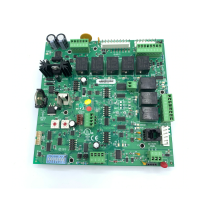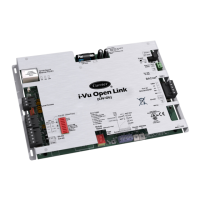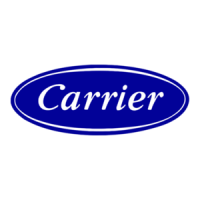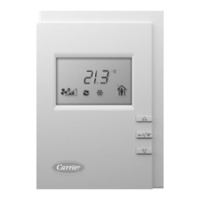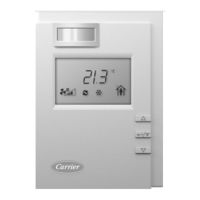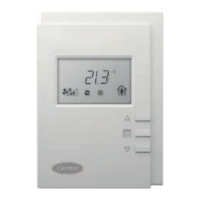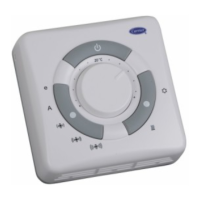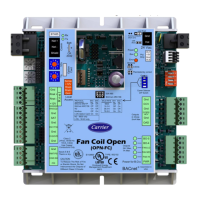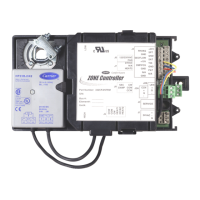22
Outdoor CO
2
Sensor Value @ Min mA – Sets the outdoor
CO
2
value when the board reads 4 mA at input 1 or 2.
Range = 0 to 9999 ppm
Default = 0 ppm
Outdoor CO
2
Sensor Value @ Max mA – Sets the outdoor
CO
2
value when the board reads 20 mA at input 1 or 2.
Range = 0 to 9999 ppm
Default = 2000 ppm
NOTE: The indoor and outdoor min and max mA setting are used
to set the linear curve of mA vs. PPM.
OPERATION
The RTU Open controller will control the compressors, econo-
mizer and heating outputs based on its space temperature input
and setpoints. It can also be controlled by a building control sys-
tem or zoning system. An optional CO
2
IAQ sensor mounted in
the space can influence the economizer minimum position. The
RTU Open controller has a hardware clock that can allow sched-
uling for stand-alone operation. The RTU Open controller's de-
fault is to control to occupied setpoints all the time, until a type
of occupancy control is set. The following sections describe the
operation for the functions of the RTU Open controller.
Occupancy
Occupancy is the fundamental overall control of equipment.
The unit can be in one of two states: Occupied or Unoccupied.
These are usually referred to as periods because they represent
periods of any given day. Before the RTU Open controller can
operate specific functions of the equipment it is installed on,
occupancy must be determined. There are four different ways
the RTU Open controller can determine occupancy. These are
described below and selected by the configuration point Occu-
pancy Source.
ALWAYS OCCUPIED (DEFAULT)
The unit will not determine occupancy and continuously run in
the occupied state or period. The RTU Open controller ships
from the factory with this setting to allow immediate operation.
BACnet SCHEDULE
When Occupancy Source is set to BACnet Schedule, the RTU
Open controller will use a schedule to change occupancy based
upon a day of week and a time period. Local time and date
should be set in the RTU Open controller for this function to
operate properly. This function applies if setting a local sched-
ule in the RTU Open controller or if applying the unit to an
i-Vu
®
Open Building Automation System or an Open zoning
system. An Open network schedule can override a local sched-
ule within the unit. A space sensor push button override is only
available when running a local or Open schedule. The push
button will override an unoccupied period to occupied for the
specified time duration.
BAS ON/OFF
When Occupancy Source is set to BAS On/Off, the RTU Open
controller follows occupancy based on an On/Off command to
the BAS ON/OFF software point. An on command sets the oc-
cupancy to occupied, and an off command sets it to unoccu-
pied. The Building Automation System can be speaking BAC-
net, Modbus, N2, or LON and is writing to the BAS On/Off
point in the open protocol point map.
REMOTE OCC INPUT
When Occupancy Source is set to Remote Occ Input, the RTU
Open controller follows occupancy based on the remote occu-
pancy switch input. Inputs 3, 5, 8, and 9 on plug J5 can be
hard-wired to command the unit's occupancy. The Occupancy
Contact point show the status as on or off, on is occupied and
off is unoccupied.
Indoor (Supply) Fan
The indoor fan can be configured to operate in three different
manors. The configuration point Fan Mode determines how the
fan will run. The fan will always be disabled if a fire shutdown
or safety chain alarm is active. A valid space temperature and
supply air temperature must be available for the fan to operate.
There is a unit start delay in effect when the unit is transition-
ing from unoccupied to occupied. The following describes spe-
cific fan operation based on the Fan Mode configuration value.
AUTO
When Fan Mode is set to Auto, the RTU Open controller will
cycle the fan on and off based on the demand for heating, cool-
ing, and dehumidification. There is a configurable fan off delay
that is upheld before shutting the fan off after conditioning has
ended.
CONTINUOUS
When Fan Mode is set to Continuous, the RTU Open controller
will cycle the fan based on occupancy. The fan will run contin-
uously whenever the unit is occupied and operate in the auto
mode during the unoccupied period.
ALWAYS ON
When Fan Mode is set to Always On, the RTU Open controller
will run the fan all the time regardless of occupancy or demand.
FAN OFF DELAY
A Fan Off Delay allows the supply fan to continue operating
after heating or cooling stops. If the following alarms are ac-
tive, the fan turns off immediately, regardless of the occupancy
state or demand:
• Fire Shutdown
• Safety Chain
• Supply Air Temp Sensor alarm
The RTU Open controller does not include smoke-control
functions such as smoke-purge, zone-pressurization, or smoke-
ventilation.
INDOOR (SUPPLY) FAN STATUS
The RTU Open controller has an optional Supply Fan Status
input to provide proof of airflow. If this is enabled, the point
will look for a contact change whenever the Supply Fan Relay
is on. If it is not enabled then it will always be the same state as
the Supply Fan Relay. The cooling, economizer, heating, dehu-
midification, CO
2
and power exhaust routines will use this in-
put point for fan status.
Cooling
The compressor outputs are controlled by the Cooling Control
PID Loop and Cooling Stages Capacity algorithm. They will
be used to calculate the desired number of stages needed to sat-
isfy the space by comparing the Space Temperature (SPT) to
the Occupied Cool Setpoint plus the T56 slider offset when oc-
cupied and the Unoccupied Cool Setpoint (UCSP) plus the T56
slider offset, if unoccupied. The economizer, if available, will
be used for cooling in addition to the compressors. The follow-
ing conditions must be true in order for this algorithm to run:
• Outdoor Air Temperature, if valid, is greater than the
Cooling Lockout Temperature setpoint.
• Indoor Fan is ON.
• Heat mode has not been active for 5 minutes.
• If occupied and the SPT > (occupied cool setpoint plus the
T56 slider offset).
• Space Temperature and supply air temperature values are
valid.
• If it is unoccupied and the SPT > (unoccupied cool set-
point plus the T56 slider offset).

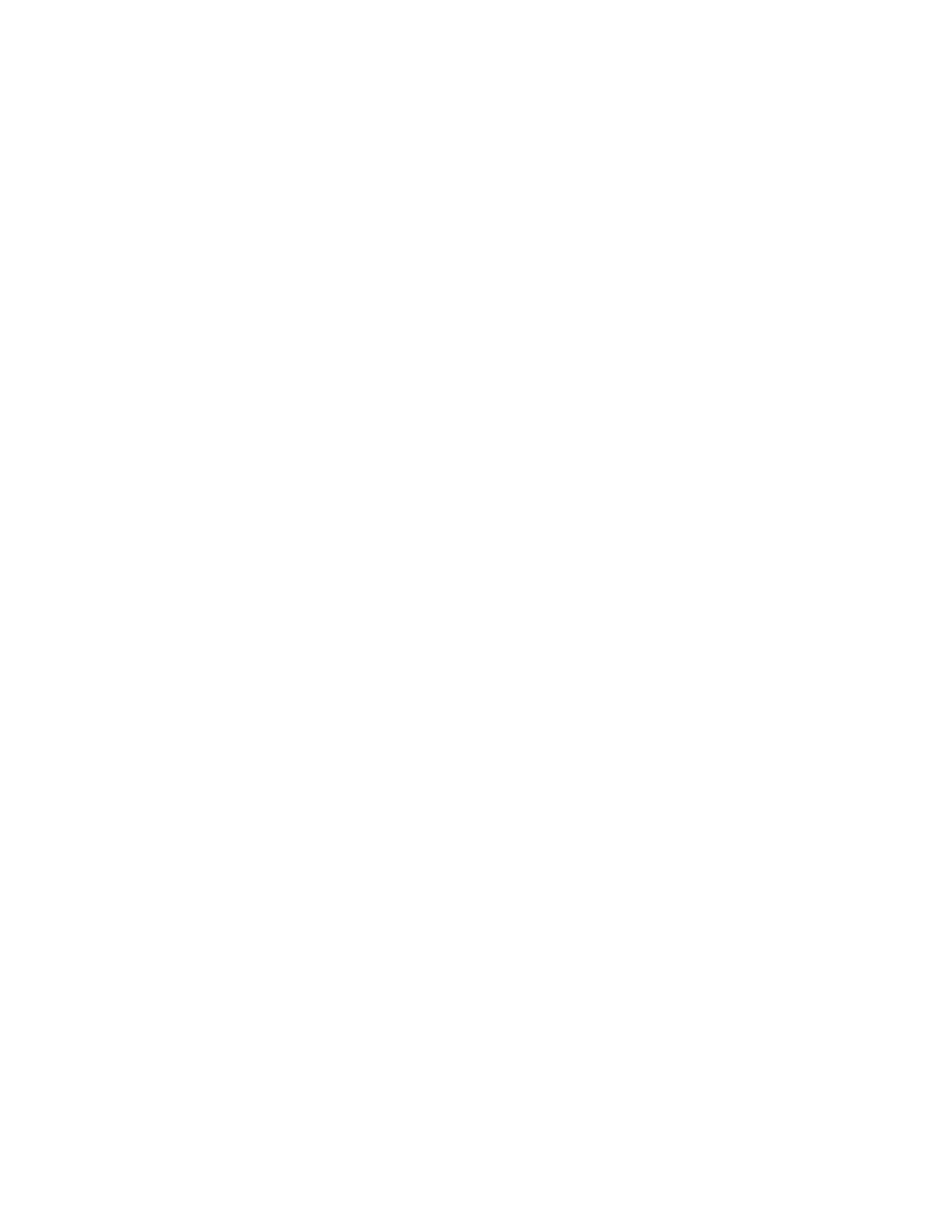